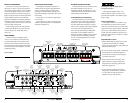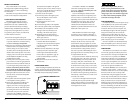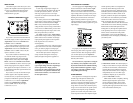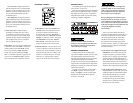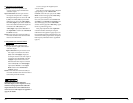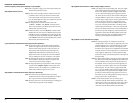
SPEAKER OUTPUTS
The G6600’s speaker outputs are designed to
accept 16 AWG - 8 AWG wire.
Each pair of the G6600’s channels are designed to
deliver power into speaker loads equal to or greater
than 2 ohms when using a “stereo” configuration
and speaker loads equal to or greater than 4 ohms
when using a “bridged” configuration.
Speaker loads below 2 ohms nominal per
channel are not recommended and may cause
the amplifier to initiate a protection mode
which reduces power output.
BRIDGING CONSIDERATIONS
Bridging is the practice of combining the
output of two amplifier channels to drive a single
load. When bridged, each channel produces
signals of equal magnitude, but opposite polarity.
The combined output of the two channels
provides twice the output voltage available from a
single channel. The G6600 has been designed for
bridging of its channel pairs without the need for
input inversion adaptors.
To bridge a pair of channels, use the “Left +”
and “Right –” speaker connectors only (the
“Left –” and “Right +” remain unused). When
bridged, each channel will deliver optimum
power into a 4 ohm load.
When a pair of channels are bridged, they
will deliver 200W x 1 into a 4 ohm load or
150W x 1 into an 8 ohm load. Operating a
pair of bridged channels into a load lower
than 4 ohms is not recommended.
Because a bridged pair of channels requires
that both channels receive input, you need to
connect both left and right inputs to the source
unit. Connection of only one input will result in
reduced power output, increased distortion and
can cause the amplifier to overheat.
Do not do this!
When a pair of the G6600’s channels are
operating in bridged mode, the output will be in
mono (only one channel). This mono channel
can contain right channel only information,
left channel only information or the sum of
the information from both the right and left
channels. In order to achieve one of these options,
configure the inputs to that pair of channels in
one of these two ways:
1) Left Channel Only or Right Channel Only
Information: If you wish to send a left-only
or right-only signal to a pair of the G6600’s
channels, use a “Y-Adaptor” to split the single
channel signal into both left and right RCA
inputs. This option is useful when using a pair
of the G6600’s channels to drive left channel
speakers only and the other pair of the G6600’s
channels to drive right channel speakers only.
2) Left + Right Channel Information: When
bridged and fed by a stereo input, a pair of the
G6600’s channels will automatically combine
the left and right channels into a summed
mono (left + right) channel. This option
is useful when using a pair of the G6600’s
channels to drive a subwoofer system or a
summed mono center channel.
“LP” (Low-Pass): Configures the filter to
attenuate frequencies above the selected filter
frequency at a rate of 12dB per octave. This is
useful for connection of subwoofer(s) to one
or more of the G6600’s channel pairs in a
bi-amplified system.
“HP” (High-Pass): Configures the filter to
attenuate frequencies below the selected filter
frequency at a rate of 12dB per octave. This is
useful for connection of component speakers to
one or more of the G6600’s channel pairs in a
bi-amplified system.
2) “Filter Freq. (Hz)” The filter frequency
markings surrounding this rotary control
are for reference purposes and are generally
accurate to within 1/3 octave or better. If you
would like to select the filter cutoff frequency
with a higher level of precision, consult the
chart in Appendix B (page 15).
Tuning Hint: If you are using the G6600 to drive
a subwoofer system (“LP” mode), a component
satellite speaker system (“HP” mode) or both,
80 Hz is a good baseline “Filter Freq. (Hz)”
setting. After properly adjusting the “Input
Sens.”, as outlined in Appendix A (page 14), you
can fine tune the “Filter Freq. (Hz)” control to
achieve the desired system frequency response.
BASS BOOST CONTROLS
1) “Bass Boost”: Found in the “Channel 5 & 6
Controls” section, this switch allows the user
to activate a 6 dB boost centered at 48 Hz
for channels 5&6. When the “Bass Boost” is
activated, the inputs to “CH 5 (Left)” and “CH
6 (Right)” are summed to create a mono signal.
The “Filter Mode” switch in the “Channel
5 & 6 Controls” section must be in the “LP”
position for the bass boost to be functional.
2) “Remote Bass Port”: This port allows you to
connect an optional remote boost knob (sold
separately as JL Audio Model RBC-1) that can
be mounted in the front of the vehicle. With
the RBC-1 connected, the boost is no longer
limited to 0 or +6 dB, allowing a variable
range of 0 to +12 dB of boost to be selected.
8 JL AUDIO G6600 JL AUDIO G6600 9




